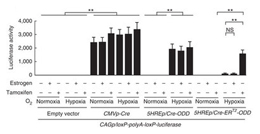Research Abstract
放射線治療を生き延びたがん細胞はHIF-1活性を獲得して腫瘍内血管に向かって移動する
Cancer cells that survive radiation therapy acquire HIF-1 activity and translocate towards tumour blood vessels
2012年4月17日 Nature Communications 3 : 783 doi: 10.1038/ncomms1786

がんの再発は放射線治療後にしばしば起こるが、放射線照射に抵抗性を示すがん細胞の特性、腫瘍内での局在場所や照射後の挙動はほとんどわかっていない。今回我々は、放射線照射時に壊死領域に隣接して存在していた細胞について、照射後の挙動を追跡する巧妙な方法を開発した。壊死部に隣接する腫瘍細胞は本来、低酸素誘導性因子1(HIF-1)陰性であるが、放射線照射を生き延びた後にHIF-1活性を獲得し、これによって腫瘍内血管に向かって移動するようになる。HIF-1阻害剤はこの移動を抑制し、放射線照射後の腫瘍再発の発生率を低下させる。我々のデータは、放射線を生き延びた細胞が、がんの再発過程で、HIF-1依存的にダイナミックに動くことを初めて明らかにしたものであり、同時に放射線治療後にHIF-1を標的とすることの論理的根拠を与えるものである。
- 京都大学生命科学系キャリアパス形成ユニット
- 京都大学医学部附属病院 放射線治療科
- 大阪府立成人病センター 生化学部門
- 京都大学医学部附属病院 麻酔科
- Fourth Military Medical University(中国)
- オックスフォード大学(英国)
Tumour recurrence frequently occurs after radiotherapy, but the characteristics, intratumoural localization and post-irradiation behaviour of radioresistant cancer cells remain largely unknown. Here we develop a sophisticated strategy to track the post-irradiation fate of the cells, which exist in perinecrotic regions at the time of radiation. Although the perinecrotic tumour cells are originally hypoxia-inducible factor 1 (HIF-1)-negative, they acquire HIF-1 activity after surviving radiation, which triggers their translocation towards tumour blood vessels. HIF-1 inhibitors suppress the translocation and decrease the incidence of post-irradiation tumour recurrence. For the first time, our data unveil the HIF-1-dependent cellular dynamics during post-irradiation tumour recurrence and provide a rational basis for targeting HIF-1 after radiation therapy.

